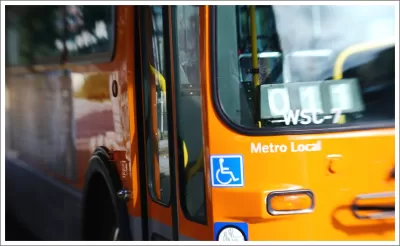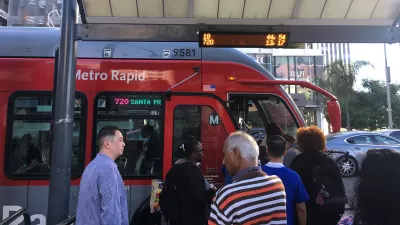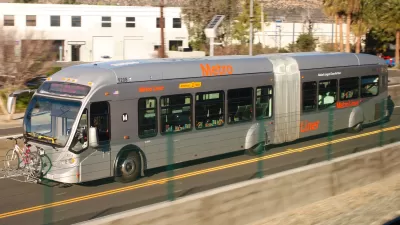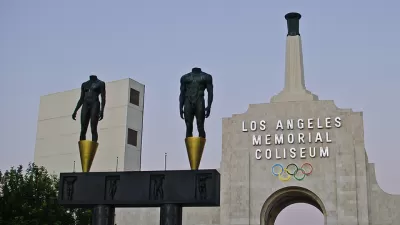One of the largest transit systems in the country continues to lose large numbers of riders. But the causes behind the drop and the solutions to stop it are hard to pinpoint.

Laura J. Nelson reports on the current state of transit ridership in Los Angeles County. The Los Angeles County Metropolitan Transportation Authority’s bus system alone has seen a drop in ridership of 25 percent, or 95 million trips, in the last decade.
The reasons for the decline vary and include a stronger economy—when people buy cars—and a decrease in immigration as well as a network of bus service that critics say does not meet the needs of riders.
"The bus exodus poses a serious threat to California’s ambitious climate and transportation goals. Reducing traffic congestion and greenhouse gas emissions will be next to impossible, experts say, unless more people start taking public transit," writes Nelson.
The solutions are varied as well. Metro has its eye on bringing in new riders who now drive by speeding up travel times and by better targeting service to places people need to go. But transit advocates say that improvements should focus more on the needs of existing riders, many of whom are Latino and black and are dependent on transit. They want Metro to put in more bus-only lanes and implement all-door boarding to decrease travel times, and they want to see more buses on the streets.
Still, the challenges to increasing ridership on buses in Los Angeles are immense. "When someone buys a car, they become less likely to take transit and more likely to drive, studies show. Non-car owners now have more alternatives than ever, including Uber and Lyft, car-sharing services like Zipcar, and rental bikes and scooters," notes Nelson.
FULL STORY: L.A. is hemorrhaging bus riders — worsening traffic and hurting climate goals

Planetizen Federal Action Tracker
A weekly monitor of how Trump’s orders and actions are impacting planners and planning in America.

Restaurant Patios Were a Pandemic Win — Why Were They so Hard to Keep?
Social distancing requirements and changes in travel patterns prompted cities to pilot new uses for street and sidewalk space. Then it got complicated.

Map: Where Senate Republicans Want to Sell Your Public Lands
For public land advocates, the Senate Republicans’ proposal to sell millions of acres of public land in the West is “the biggest fight of their careers.”

Maui's Vacation Rental Debate Turns Ugly
Verbal attacks, misinformation campaigns and fistfights plague a high-stakes debate to convert thousands of vacation rentals into long-term housing.

San Francisco Suspends Traffic Calming Amidst Record Deaths
Citing “a challenging fiscal landscape,” the city will cease the program on the heels of 42 traffic deaths, including 24 pedestrians.

California Homeless Arrests, Citations Spike After Ruling
An investigation reveals that anti-homeless actions increased up to 500% after Grants Pass v. Johnson — even in cities claiming no policy change.
Urban Design for Planners 1: Software Tools
This six-course series explores essential urban design concepts using open source software and equips planners with the tools they need to participate fully in the urban design process.
Planning for Universal Design
Learn the tools for implementing Universal Design in planning regulations.
Heyer Gruel & Associates PA
JM Goldson LLC
Custer County Colorado
City of Camden Redevelopment Agency
City of Astoria
Transportation Research & Education Center (TREC) at Portland State University
Camden Redevelopment Agency
City of Claremont
Municipality of Princeton (NJ)





























